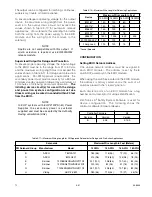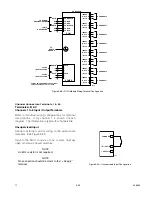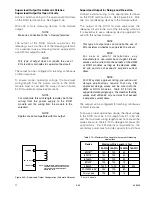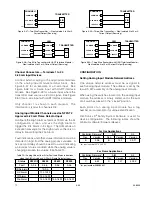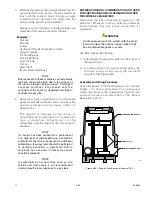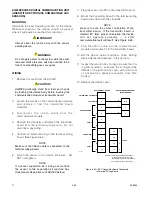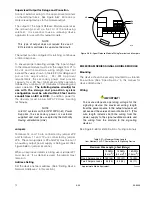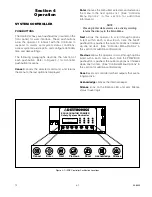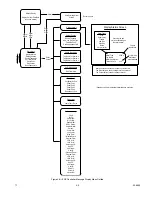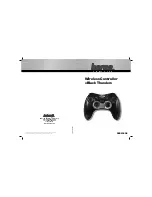
3-45
7.1
95-8533
C. Materials that remove the catalytic metals from the
active element of the sensor. Some substances
react with the catalytic metal forming a volatile
compound that can erode the metal from the
surface of the sensor’s active element.
Halogens and compounds containing halogen are
materials of this nature and others include:
Examples:
Chlorine
Bromine
Iodine
Hydrogen Chloride, Bromide or Iodide
Organic halides:
Trichloroethylene
Dichlorobenzene
Vinyl chloride
Freons
Halon 1301
(Bromotrifluoromethane).
NOTe
Brief exposure to these materials can temporarily
increase sensor sensitivity due to the surface of
the active element being etched. Prolonged
exposure continues this process until the
sensitivity of the sensor is degraded, resulting in
shortened sensor life.
D. Exposure to high concentrations of combustible
gases for extended periods of time can stress the
sensing element and seriously affect its
performance.
The degree of damage to the sensor is
determined by a combination of contaminant
type, contaminant concentration in the
atmosphere, and the length of time the sensor is
exposed.
NOTe
If a sensor has been exposed to a contaminant
or a high level of combustible gas, it should be
calibrated at the time of exposure. An additional
calibration a few days later should be performed
to determine whether a significant shift in
sensitivity has occurred. If necessary, sensor
should be replaced.
NOTe
A combination of accessories such as rain
shields and dust covers is not recommended
and can result in slow response to a gas leak.
EQ22XXDCU DIGITAL COMMUNICATION UNIT USED
WITH DET-TRONICS H2S/O2 SENSORS OR OTHER
TWO-WIRE 4-20 MA DEvICES
Determine the best mounting locations for the
detectors. Whenever practical, detectors should be
placed where they are easily accessible for
calibration.
WARNING!
Do not apply power to the system with the cover
removed unless the area has been verified to be
free of combustible gases or vapors.
The DCU utilizes the following:
1. A terminal wiring board mounted at the bottom of
the junction box.
2. A communication module mounted above the
terminal wiring board using the standoffs
provided. See Figure 3-60.
Assembly and Wiring Procedure
Attach the sensor to the DCU enclosure. Do not over-
tighten. If a sensor separation kit is being used,
attach the sensor to the separation kit junction box
and wire the device as described in the “Sensor
Separation” section.
A1571
COMMUNICATION MODULE
STANDOFFS (4)
TERMINAL WIRING BOARD
Figure 3-60—Printed Circuit Boards in Universal DCU
Summary of Contents for DET-TRONICS 95-8533
Page 128: ...7 1 95 8533 A 4 Figure A 1 System Drawing 007545 001 ...
Page 129: ...95 8533 A 5 7 1 Figure A 2 System Drawing 007545 001 ...
Page 131: ...95 8533 7 1 B 2 Figure B 1 Drawing 007546 001 ...
Page 132: ...95 8533 7 1 B 3 Figure B 2 Drawing 007546 001 ...
Page 134: ...95 8533 7 1 C 2 Figure C 1 Drawing 007547 001 ...
Page 141: ...95 8533 7 1 D 7 Figure D1 System Drawing 007545 001 ...
Page 143: ...APPENDIX E E 1 95 8533 7 1 ...

